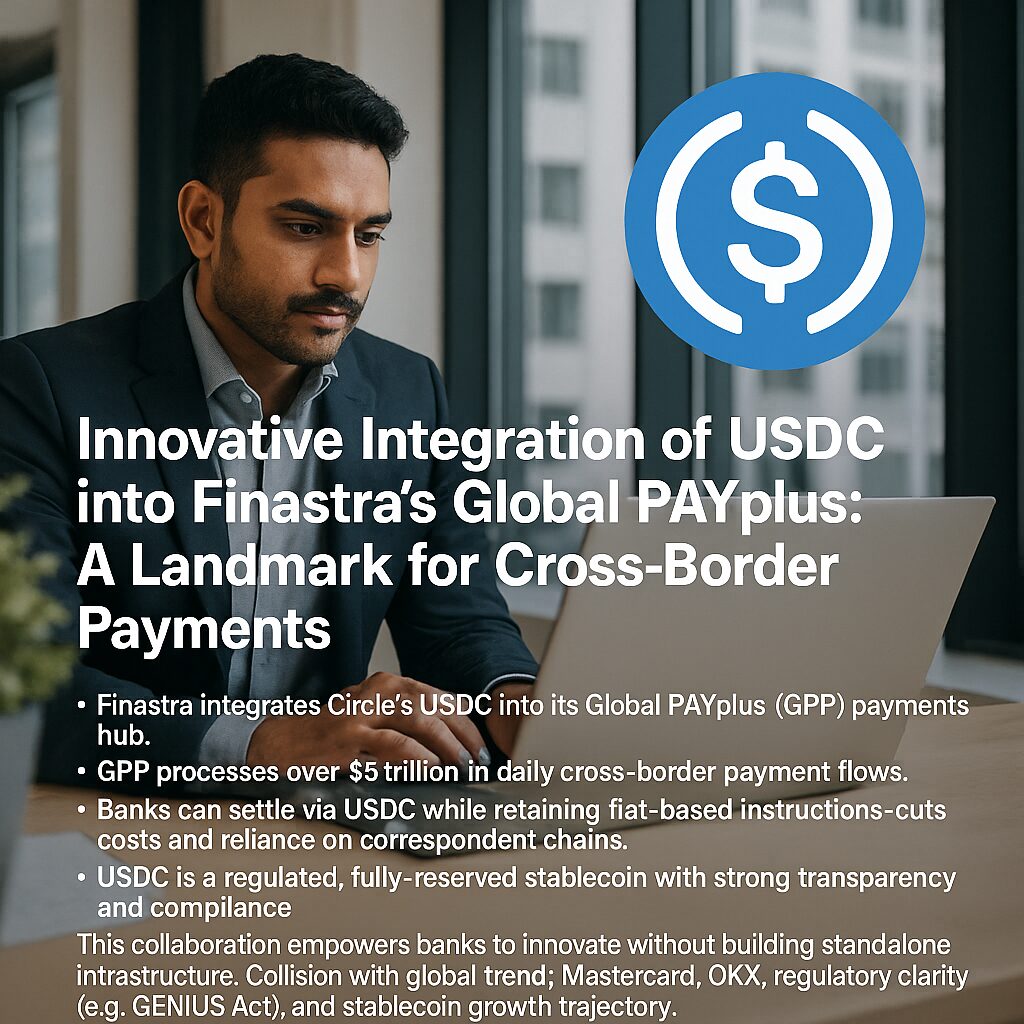
Main Points :
- Finastra integrates Circle’s USDC into its Global PAYplus (GPP) payments hub.
- GPP processes over $5 trillion in daily cross‑border payment flows.
- Banks can settle via USDC while retaining fiat‑based instructions—cuts costs and reliance on correspondent chains.
- USDC is a regulated, fully‑reserved stablecoin with strong transparency and compliance.
- This collaboration empowers banks to innovate without building standalone infrastructure.
- Collision with global trend: Mastercard, OKX, regulatory clarity (e.g. GENIUS Act), and stablecoin growth trajectory.
Background & Strategic Significance
Background & Strategic Significance
Finastra, a London‑based financial software provider trusted by over 8,000 clients—including 45 of the world’s top 50 banks across more than 130 countries—has entered into a strategic collaboration with Circle to integrate the USD Coin (USDC) stablecoin into its Global PAYplus (GPP) payment hub. The GPP platform processes an astounding $5 trillion in daily cross‑border transaction flows, underscoring the scale of global financial infrastructure it supports.
What the Integration Enables
What the Integration Enables
Under this integration, banks using GPP can settle cross‑border transfers in USDC while preserving fiat‑denominated payment instructions on both ends. This hybrid approach allows financial institutions to take advantage of blockchain’s speed and cost efficiency without overhauling existing compliance or FX workflows.
Benefits of USDC & Industry Momentum
Benefits of USDC & Industry Momentum
USDC is a fully‑reserved, regulated stablecoin, pegged 1:1 to the US dollar, with regular attestations ensuring transparency. Its sizable supply—about $69 billion—makes it the second-largest stablecoin in circulation. Its integration further signals increasing institutional openness to stablecoin alternatives to costly and slow correspondent banking networks.
Furthermore, this move aligns with broader trends: Mastercard is bringing USDC and Euro Coin settlement to merchants in EEMEA; Circle signed a zero-fee USDC conversion deal with OKX; regulatory frameworks like the US GENIUS Act are paving a path toward clarity; and Coinbase projects stablecoin market growth to $1.2 trillion by 2028.
Strategic Quotes from Leadership
Strategic Quotes from Leadership
Chris Walters, CEO of Finastra, emphasized:
“This collaboration is about giving banks the tools they need to innovate in cross‑border payments without having to build a standalone payment processing infrastructure.”
— signaling the ease of adoption for banks leveraging the existing GPP platform.
Jeremy Allaire, CEO of Circle, added:
“Together, we’re enabling financial institutions to test and launch innovative payment models that combine blockchain technology with the scale and trust of the existing banking system.”
— underscoring the synergy between blockchain speed and traditional financial trust.
Broader Ecosystem Context & Recent Developments
Broader Ecosystem Context & Recent Developments
This collaboration follows Circle’s broader push to embed USDC in mainstream finance. For example, Mastercard’s integration enables settlement via USDC and EURC in Eastern Europe, the Middle East, and Africa. Circle also signed an agreement with OKX for zero‑fee conversions, expanding liquidity or accessibility. Additionally, regulatory developments like the GENIUS Act are boosting institutional confidence in stablecoins.[Diagram or infographic illustrating Finastra–Circle integration within GPP, with flow from fiat instructions to USDC settlement]

Implications for Banks, Investors, and Blockchain Practitioners
Implications for Banks, Investors, and Blockchain Practitioners
For banks, this integration offers a low‑friction path to adopt blockchain settlement methods, enabling near‑instant transactions, lower fees, and reduced dependency on correspondent banking.
For crypto‑savvy investors and innovators, the move marks validation of stablecoin infrastructure’s maturity and institutional traction. A growth‑oriented strategy like this supports evaluating USDC-like instruments for treasury or cross-border use cases.
For blockchain practitioners, it opens new corridors where token rails plug into entrenched finance. Combining fiat messaging with digital settlement models paves the way for hybrid finance architectures—perhaps extending to tokenized assets, programmable liquidity, and real‑time settlement platforms.
Summary & Future Outlook
In summary, the integration of USDC into Finastra’s Global PAYplus via Circle is a breakthrough in bridging traditional banking and blockchain settlement. By marrying $5 trillion-a-day cross‑border infrastructure with regulated, transparent stablecoin rails, this initiative could reshape how international payments are executed—faster, cheaper, and more flexible.
Moving forward, we can expect:
- Expansion to more financial institutions across regions, following EEMEA and Asia momentum.
- Experimental offerings, such as tokenized FX rails, real‑time liquidity pools, or smart‑contract‑driven net settlement.
- Ongoing evolution of regulatory frameworks globally to support institutional-grade stablecoin use.
Conclusion
This development exemplifies the practical, scalable integration of blockchain solutions into established financial infrastructure. It offers a powerful new tool for banks to evolve cross‑border payments and signals exciting opportunities for innovators seeking to build the next wave of token‑enabled financial applications.

